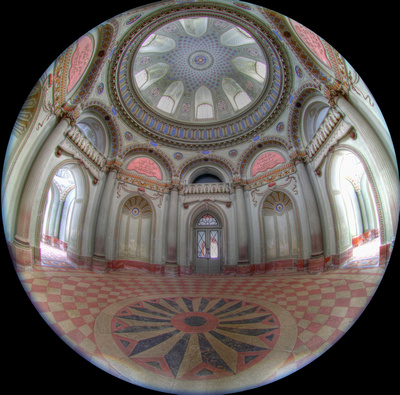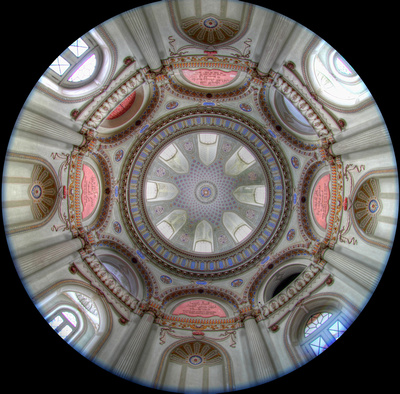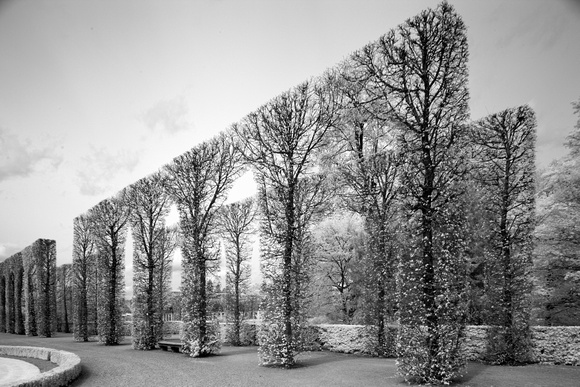Welcome to my Photo Blog!
Is Faster Better?
Many articles describe the advantages of fast lenses - meant are lenses which have a wide maximum aperture and which let a lot of light in. The wider open the aperture blade, the smaller the f-number. Fast is somehow defined by being at least f-stop f/2.8 or even better with a lower aperture number than this f-stop. For every f-stop faster - full f-stops fastest to slower apertures are f/1.0, f/1.4, f/2.0, f/2.8, f/4.0, f/5.6 - the aperture hole has to double its size for each stop faster. Lenses are defined by their maximum aperture. An example is this: The 35 f/2.0 only allows in half the light of the 35 f/1.4 at its maximum aperture.
Fast lenses need larger glass since it needs to accommodate for the larger maximum aperture hole of the blades. The size of the lens also depends on the focal length - longer focal lengths need larger glass, too. And now we see the two main disadvantages of fast lenses - weight and cost. Larger glass requires larger lens barrels, more difficult optical design, and more sophisticated quality control of the lens parts. Most modern consumer zoom lenses are slower lenses with maximum apertures between f/3.5 and f/5.6. They are light and less bulky - ideal for carry-on luggage and traveling.
But fast lenses have a few unbeatable advantages speaking for themselves: normally lenses are sharpest a few stops beyond the maximum aperture. A 50 f/2.8 would be likely sharpest at f/5.6 or f/8. If we now have a 50 mm lens with a larger maximum aperture of f/1.4 for example, we suddenly reach the peak of lens sharpness already around f/2.8 to f/4.0! This means we can work under much more difficult light conditions with wider open apertures and also achieving the same sharpness!
Faster f-stops allow the photographer to create much more creative photos by making use of the shallow depth of field (DoF) at wide maximum aperture numbers. The DoF at f/1.0 is so shallow that focusing on the right spot gets extremely difficult. Fast apertures are also very demanding for every autofocus (AF) system in cameras since it makes it harder and harder for the electronic focus system to determine the focus spot accurately enough. Microfocus adjustment of lens and camera together is highly recommended here to compensate for tiny camera body and lens variations which can otherwise easily lead to front- or backfocus issues. Unfortunately not every DSLR camera has this option included yet. Beautiful DoF examples can be created with flowers like the one on the left. The center is kept sharp, while the petals become more blurry with a wider aperture which gives the photo some sort of motion effect.
Bigger lenses let a lot more light pass through the sensor and the viewfinder itself! When I bought my first fast lenses, it amazed me how much brighter the view through my fast lens got. Manual focusing was so much easier! Sometimes the light transmission was so good that I had to underexpose my photos with up to -2/3 stops of exposure compensation. My 50 f/1.2 lens - it is the fastest lens which I own so far! - is a good example for this phenomena. Of course this effect is perfect for shooting in dim light conditions or especially in the night. The photo of the shell was taken under a dim light and manual focus with my 50 f/1.4 at f/2.2 without tripod support.
Often forgotten is another quite interesting positive effect of fast lenses - the very smooth bokeh effect. Bokeh derives from the Japanese and stands in photography for an aesthetic quality of blur. This effect is mostly caused by the lens design itself and by the shape of the lens aperture blades. Smaller apertures lead to more unwanted hard-edged bokeh, while fast lenses with wide maximum apertures give desirable smooth bokeh circles. A good example for this effect with a fast lens is one of my Christmas photos below.
I used my 135 f/2.0 lens wide open at f/2.0 for this shot. The out of focus lights appear in circular or oval shapes with no sign of edges which gives a mix of unreal and dreaming effect.
It takes some effort as amateur to vest into a bunch of fast prime lenses. But I guarantee you that you will hold onto them because they enable you to take photos in a way you would not be able to do with slower zoom lenses.
Let's Get Fishy!
This blog gives some insight to one of my most creative lenses on full frame, the 8 mm fisheye lens. 8 mm focal length provides a circular 180 degree image on a full frame sensor. There are a few suppliers which manufacture 8 mm fisheye lenses suitable for full frame sensors. I found the best quality for the bucks can be achieved with the manual Peleng 8 mm f/3.5 lens. Made in the Ukraine, the Peleng lens is not a common lens. It was developed during the Russian space research program to provide superwide 180 degree images of the space. A while ago it was commercialized and also adapted to fit to DSLR cameras. It is a very compact, but heavy lens with one of the best built qualities compared to other lens bodies I have seen so far. Stepped down a bit it provides an excellent center sharpness which is still remarkable at the circular borders on full-frame. The characteristic feature of this lens is its rounded huge front lens without the option to use filters on top of it. A small UV filter is built into the lens body close to the adapter mount. The filter can be removed, but it is recommended to keep it since it is also used as a necessary lens element. When holding the front lens into the light, you will see differently colored reflections on the lens coating depending on the light angle.
It is surprising that I never had to change contrast or saturation of taken RAW photos with this lens - the color reproduction is superb, you might need to underexpose a bit to achieve better contrast especially at wider open apertures.
Main issue of this lens is getting lens flares opposite to the position of the light source. This is nearly unavoidable with such 180 degree field of view. Flares sometimes create additional artistic effects. Best way to remove those flares is to apply a circular crop of the taken photo in post processing. Other 8 mm prime lenses might be better in this regard and not as prone to flaring - but they cost at least more than twice the money and have no full metal lens body!
The lens allows to use apertures between f3.5 and f16 in 6 stops. Best sharpness is achieved at f8-11. Chromatic aberrations are much less than I expected after reading some reviews. In fact my Canon 17-40 mm f4 L lens shows more purple fringing at 17 mm uncorrected than this lens does.
The photo on the left is an ideal situation for making use of the circular 180 degrees - the crosswalk and the architectural design of it shines within this view. Just make sure that your shoes won't be in the photo!
Architecture is one of the best situations where this lens can be used. The photos below were taken inside a mosque which is located inside a castle garden of my hometown in Germany. Both are HDR (high dynamic range) photos to compensate for the bright light coming through the windows and the darker inside of the room leaving the bright colorful wall paintings as seen with your eye. The photo on the left is the central view, while the right photo is directly pointed towards the circular ceiling.




Looking more into creative aspects, the photo on the left shines a different light on a very common object. Can you guess what it is? The circular distortion brings out totally different elements in the perspective view.
Another example is the photo below - as you might have already guessed, it shows the inside of a hot air balloon. At the balloon festival they charged visitors an entrance fee to go inside balloons and to take photos - here I found my Peleng lens to be a useful spy lens! I just needed a brief moment outside at the entrance door to take this photo through the opening - and got at once the whole inside area.
Fisheye shots allow for unusual compositions like the photo of the inside of a wedding pavillion outside. The round roof shape was ideal for the circular field of view at 8 mm full frame. I was lucky enough to get the cloud structure into the center.
If you want a fun lens to do some more creative shots of landscapes and architecture without getting too serious about it, then this is the right lens for you. It is not my most commonly used lens, but there are situations where it is just the best to cover the situation.
Infrared Full Frame
In the past I used my older Rebel XT (EOS 350D) DSLR camera for infrared (IR) photography simply by attaching a 720 nm infrared filter onto the front lens. Main disadvantage with this method are longer exposure times between 5-15 seconds depending on light conditions. Focusing was a bit tricky, too - this camera has no Live View built in, so I had to rely on experience and the red focus mark on the lens. Several photos were needed to get one decent sharp one. I quickly grew out of this bit of cumbersome infrared shooting technique: I no longer wanted to rely on static objects to take infrared photos of; also I found myself limited by the APC-S cropped sensor in the Rebel camera which made it hard to get a wider field of view with my good wide angle lenses.
The anti-alias and the hot mirror filter (AA/ICF) in front of my full frame 5D II camera is very strong - I can confirm posts of disappointed IR photographers who tried the IR filter-on-lens method with this full frame camera. Very long exposure times about 30 seconds are needed, and unfortunately some regular light passes through due to the very long exposure. The IR photo doesn't look right, the white reflective tones are all greyish looking. Post processing can't resolve this either.
Finally in April 2012 I had a second 5D MkII camera body converted to an infrared camera with 715 nm cutoff filter. To do this, the AA/ICF filters in front of the CMOS sensor had to be replaced. The ultrasonic sensor cleaning was disabled, too - the piezo strips of the cleaning device are directly glued on the AA/ICF which had to be removed.
I have used now my IR camera on many occasions, and it is a blast! I am able to create photo compositions which are just impossible to do in regular light or normal B&W photography. Clouds and foliage appear bright and very rich in contrast, while water is mostly pitch black.
 This moment on the left photo remained only for less than 2 minutes, and I was fortunate just to have my IR camera with lens ready to take a shot of this scenery! This picture in regular color would look much less impressive.
This moment on the left photo remained only for less than 2 minutes, and I was fortunate just to have my IR camera with lens ready to take a shot of this scenery! This picture in regular color would look much less impressive.
With a 715 nm cutoff filter, still some light will be able to pass through the sensor. By converting the red/blue color channels in post processing, even some sort of color photos are possible. Personally I like it with blue sky in the background and white foreground as seen in this photo below. Especially green foliage (grass, leaves, plants) looks very vibrant in infrared. The chlorophyll in the plant cells is known to reflect infrared light which is registered by the camera. The more infrared an object reflects, the more brighter it will appear in the photo.
This allows to take very contrast-rich photos which cannot be taken in regular light or the same effects achieved by professional post processing software. My converted IR camera can be used in infrared nearly the same as my regular light camera body. Focusing works the same (it is calibrated after the conversion, but I recommend also using microfocus adjustment for commonly used lenses). Metering is a bit more tricky - it can change severely by just moving the camera from a specific angle to the sun for example. Get used to manual mode or at least under/overexposure settings! +/- 1 to 2 stops exposure compensation settings are totally normal.
This goes in line with using one of my favorite lenses, the 24 mm f/3.5 tilt/shift lens. I love this lens for architectural and landscape shots since I can avoid distorted lines by shifting and increasing (or decreasing) the depth of field (DoF) by tilting. Now I can use my favorite wide angle lens in infrared, too! The photo below which was taken inside a castle garden could not be accomplished with a regular 24 mm wide angle lens - do you see the straight vertical tree lines? Infrared gives the additional "touch" by showing the young leaves and bushes in a bright contrast to the dark tree stems.


Other than nature, IR photography is a useful tool in the mechanical/technical area. Its better contrast-rich photos bring out details a lot better and appealing. The HDR (high dynamic range) photo below of an opened turbine of a FedEx cargo airplane was taken at 17 mm focal length. Small differences in light give a glow to some tubes and parts, while other structures remain darker.
Last but not least my IR-converted full frame camera allows to take appealing portrait shots! One IR portrait photo of mine can be seen in the "About" section of my website here. Skin looks smoother and more even than in regular light.
Please feel free to check out my infrared photos on my website! They can be found in several galleries, with some of them in the infrared gallery.